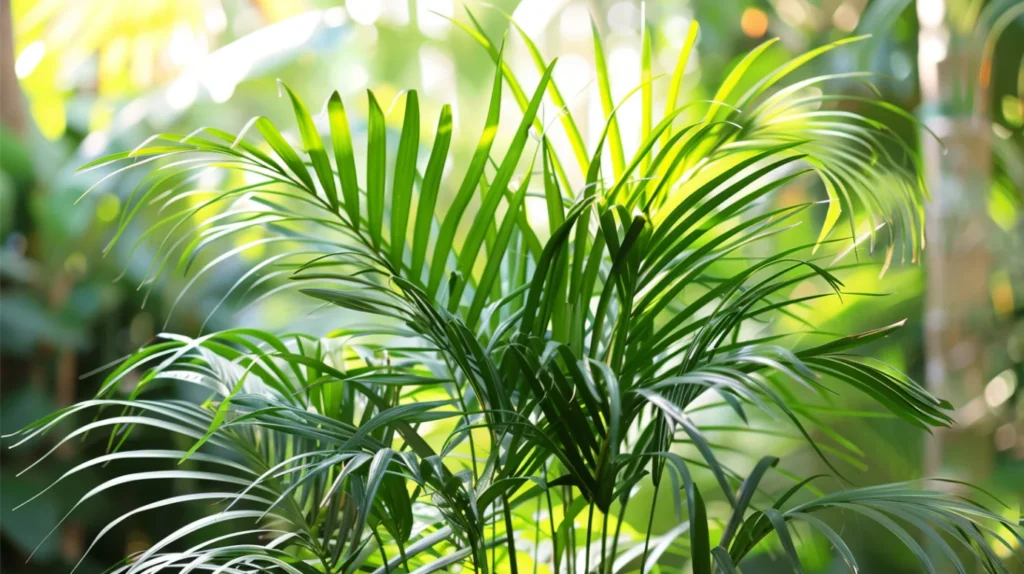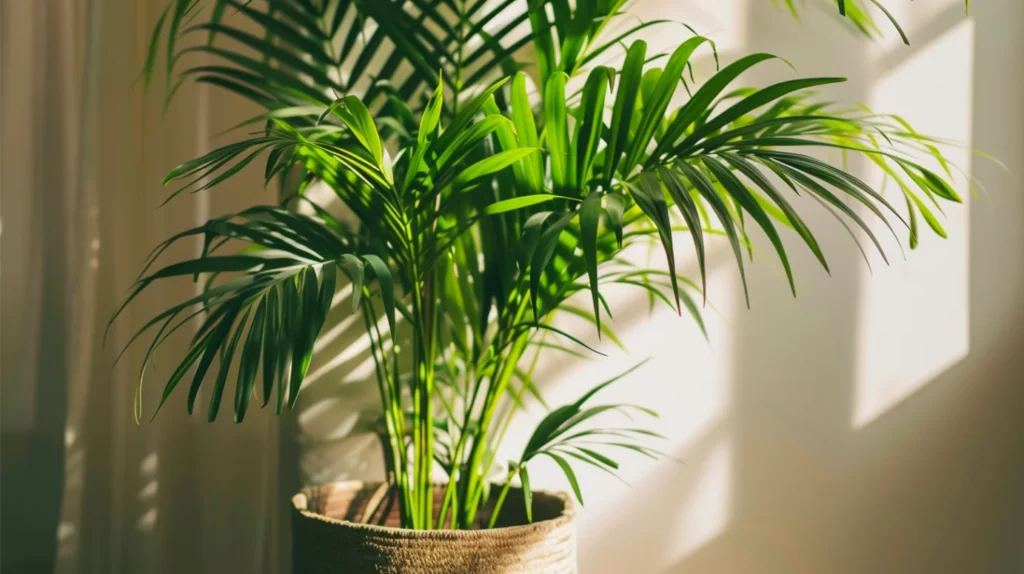Grow and Care for Areca Palm: The Ultimate Guide

Are you looking to add a touch of tropical paradise to your home or garden? Look no further than the stunning Areca Palm! These elegant, feathery palms can transform any space into a lush oasis. Whether you’re a seasoned plant parent or a budding green thumb, this comprehensive guide will teach you everything you need to know about growing and caring for Areca Palms.
Introduction to Areca Palms
Areca Palms, scientifically known as Dypsis lutescens, are popular houseplants and outdoor ornamentals that originate from Madagascar. Also known as Butterfly Palms or Golden Cane Palms, these beauties are prized for their:
- Slender, bamboo-like trunks
- Lush, arching fronds
- Air-purifying qualities
- Relatively easy care requirements
Let’s dive into the world of Areca Palms and discover how to help them thrive in your space!
The Basics of Areca Palm Care

Light Requirements
Areca Palms are sun-lovers, but they appreciate a bit of protection from intense rays. Here’s what you need to know:
- Outdoors: They can tolerate full sun but prefer partial shade to prevent frond burn.
- Indoors: Place your palm near a south- or west-facing window for bright, filtered light.
Pro tip: If your indoor Areca Palm starts to look leggy or pale, it might need more light. Consider supplementing with grow lights during darker months.
Soil and Potting
The right soil mix is crucial for your Areca Palm’s health. Here’s how to get it right:
- Outdoor palms: Use rich, slightly acidic soil with excellent drainage. Amend heavy soils with sand and peat moss to improve porosity and lower pH.
- Indoor palms: Opt for a well-draining, peat-based potting mix specifically formulated for palms.
When it comes to potting, remember:
- Choose a pot with drainage holes to prevent water-logging.
- Areca Palms prefer to be slightly root-bound, so don’t rush to repot.
- Repot every 2-3 years to refresh the soil and remove fertilizer salt buildup.
Watering Wisely
Areca Palms love moisture but are sensitive to overwatering. Follow these tips for perfect hydration:
- Allow the top 1-2 inches of soil to dry between waterings.
- Water thoroughly until you see it draining from the bottom of the pot.
- Empty any water that collects in the saucer to prevent root rot.
- Reduce watering frequency in winter when growth slows.
Remember: It’s better to underwater than overwater. Areca Palms can bounce back from drought stress, but root rot is often fatal.
Temperature and Humidity
To keep your Areca Palm happy, pay attention to its environmental preferences:
- Temperature: Aim for 70-80°F (21-27°C) during the day and no lower than 55°F (13°C) at night.
- Humidity: These tropical beauties thrive in high humidity. Aim for 50-60% relative humidity.
If your home is dry, especially in winter, try these humidity-boosting techniques:
- Use a pebble tray filled with water beneath the pot
- Group plants together to create a microclimate
- Run a humidifier nearby
- Mist the fronds regularly (but not excessively, as this can encourage fungal growth)
Fertilizing for Lush Growth
Areca Palms are heavy feeders, especially during the growing season. Here’s how to keep them well-nourished:
- Use a slow-release fertilizer high in nitrogen and potassium, or a specialized palm food.
- Apply fertilizer every 2-3 months during spring and summer.
- Reduce or stop fertilizing in fall and winter when growth slows.
- Always follow the instructions on the label to avoid over-fertilizing, which can damage roots.
Advanced Areca Palm Care Tips

Pruning and Maintenance
Areca Palms are relatively low-maintenance, but some grooming will keep them looking their best:
- Remove completely brown or yellow fronds at the base using clean, sharp pruning shears.
- Trim brown leaf tips if desired, but leave a thin brown edge to prevent further browning.
- Wipe dust from the fronds with a damp cloth to keep them looking fresh and improve photosynthesis.
Propagation
While it’s possible to grow Areca Palms from seeds, it’s a lengthy process best left to professionals. For home gardeners, the best method of propagation is through division:
- Remove the palm from its pot during repotting.
- Gently separate the root ball into smaller clumps, ensuring each has several healthy stems.
- Pot each division in its own container with fresh potting mix.
- Water well and place in a warm, humid spot to recover.
Dealing with Pests and Diseases
While generally hardy, Areca Palms can fall victim to some common houseplant pests and diseases. Here’s what to watch for:
Common Pests:
- Spider mites: Tiny pests that cause stippling on leaves. Control with insecticidal soap or neem oil.
- Mealybugs: White, cottony insects that cluster on fronds. Remove with alcohol-dipped cotton swabs.
- Scale: Small, brown, shell-like insects on stems and leaves. Scrape off gently and treat with horticultural oil.
Common Diseases:
- Root rot: Caused by overwatering. Prevent by ensuring good drainage and avoiding waterlogged soil.
- Leaf spot: Fungal disease causing brown spots on fronds. Improve air circulation and avoid wetting leaves when watering.
Prevention is key: Regularly inspect your palm and isolate any new plants before introducing them to your collection.
Troubleshooting Common Areca Palm Problems

Even with the best care, you might encounter some issues with your Areca Palm. Here’s how to diagnose and solve common problems:
Yellowing Leaves
Possible causes:
- Overwatering
- Nutrient deficiency
- Poor drainage
- Natural aging of lower fronds
Solutions:
- Check soil moisture and adjust watering schedule
- Ensure proper fertilization
- Improve drainage or repot in fresh, well-draining soil
- Remove old, yellowing fronds at the base
Brown Leaf Tips
Possible causes:
- Low humidity
- Fluoride or chlorine in tap water
- Overfertilization
Solutions:
- Increase humidity with methods mentioned earlier
- Use distilled or rainwater for watering
- Flush the soil occasionally to remove fertilizer buildup
Slow Growth or Pale Fronds
Possible causes:
- Insufficient light
- Nutrient deficiency
- Pot-bound roots
Solutions:
- Move to a brighter location or supplement with grow lights
- Fertilize according to the schedule mentioned earlier
- Repot into a slightly larger container with fresh soil
Decorating with Areca Palms
Areca Palms aren’t just beautiful; they’re versatile decorative elements that can enhance various spaces in your home or office. Here are some creative ideas:
- Living room centerpiece: Place a large Areca Palm in a decorative pot as a focal point in your living room.
- Natural room divider: Use several palms in a row to create a green partition in open-plan spaces.
- Bathroom oasis: Areca Palms love humidity, making them perfect for brightening up bathrooms.
- Office air purifier: Place an Areca Palm near your desk to improve air quality and reduce stress.
- Patio or balcony accent: Group Areca Palms with other tropical plants for a lush outdoor retreat.
Design tip: Choose pots that complement your decor style, from sleek modern planters to rustic baskets.
The Benefits of Growing Areca Palms
Beyond their aesthetic appeal, Areca Palms offer several benefits that make them an excellent choice for any plant enthusiast:
- Air purification: NASA studies have shown that Areca Palms are effective at removing indoor air pollutants.
- Humidity regulation: These palms naturally increase humidity levels, which can be beneficial in dry climates or during winter.
- Stress reduction: The presence of plants like Areca Palms has been linked to reduced stress levels and improved mood.
- Noise reduction: The large, leafy fronds can help absorb sound, making your space feel more peaceful.
- Increased productivity: Studies suggest that plants in workspaces can boost concentration and productivity.
Frequently Asked Questions About Areca Palms
To wrap up our comprehensive guide, let’s address some common questions about Areca Palms:
Q: How fast do Areca Palms grow? A: In ideal conditions, Areca Palms can grow about 6-10 inches per year until they reach their mature height.
Q: Are Areca Palms safe for pets? A: Yes, Areca Palms are non-toxic to cats and dogs, making them a safe choice for pet owners.
Q: Can Areca Palms be grown outdoors year-round? A: It depends on your climate. Areca Palms can be grown outdoors year-round in USDA hardiness zones 10-11. In cooler areas, they should be brought indoors when temperatures drop below 50°F (10°C).
Q: How long do Areca Palms live? A: With proper care, indoor Areca Palms can live for 10-15 years or more.
Q: Why are the leaves on my Areca Palm turning brown and crispy? A: This is often a sign of low humidity or underwatering. Increase humidity levels and check your watering schedule.
Conclusion: Embracing the Beauty of Areca Palms
Congratulations! You’re now equipped with all the knowledge you need to grow and care for stunning Areca Palms. These versatile, air-purifying beauties can transform any space into a tropical paradise with their lush, feathery fronds and elegant stature.
Remember, the key to success with Areca Palms lies in providing:
- Bright, filtered light
- Well-draining soil
- Consistent moisture (without overwatering)
- Adequate humidity
- Regular fertilization during the growing season
With a little patience and the right care, your Areca Palm will reward you with years of tropical beauty and improved air quality. So why wait? Bring a touch of the tropics into your life today with an Areca Palm!
Happy growing!





